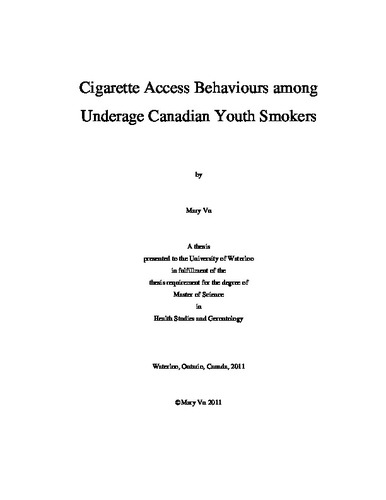| dc.description.abstract | Objective: The main objective was to examine characteristics associated with cigarette access behaviours among underage current youth smokers.
Methods: This cross-sectional study used self-reported data collected from 29,296 students in Grades 9 to 12 who participated in the 2008-09 Youth Smoking Survey (YSS), and data from the 2008-09 DMTI-EPOI (Enhanced Points of Interest) data file. Multilevel logistic regression analyses were used to jointly examine whether student characteristics and the number of tobacco retailers surrounding schools were associated with the odds of a current youth smoker accessing cigarettes from: (a) a retailer source, (b) a family member, and (c) a friend or someone else.
Results: Among underage current smokers, the majority reported usually buying their own cigarettes from a retailer (44.1%), and getting cigarettes from a friend or someone else (42.2%). Significant between-school random variation was identified for youth cigarette access from a retailer source, and from a friend or stranger. Males were more likely to buy their own cigarettes from a retailer (OR 2.08, 95% CI 1.74-2.48), whereas females were more likely to access cigarettes from a family member (OR 0.68, 95% CI 0.53-0.88), or a friend or someone else (OR 0.52, 95% CI 0.44-0.61). Binge smoking was associated with buying cigarettes from a retailer (OR 0.65, 95% CI 0.48-0.86). Youth with a smoking parent or guardian (OR 2.95, 95% CI 2.02-4.31) were more likely to get cigarettes from a family member. Youth who reported that they sometimes (OR 2.80, 95% CI 1.94-4.04), or usually or always (OR 3.15, 95% CI 2.17-4.58) share cigarettes with others was associated with accessing cigarettes from a friend or someone else. Each additional tobacco retailer surrounding a school was associated with an increased likelihood of youth purchasing their own cigarettes from a retailer (OR 1.04, 95% CI 1.01-1.07).
Conclusion: Tobacco point-of-sale restrictions are inadequate as youth can still procure cigarettes from both retailers and social sources. Future studies should explore beyond individual-level factors and examine what influences cigarette access behaviours in the broader school context. Such insight will inform the development of new school-level tobacco control initiatives that can more effectively prevent youth from acquiring cigarettes. | en |

